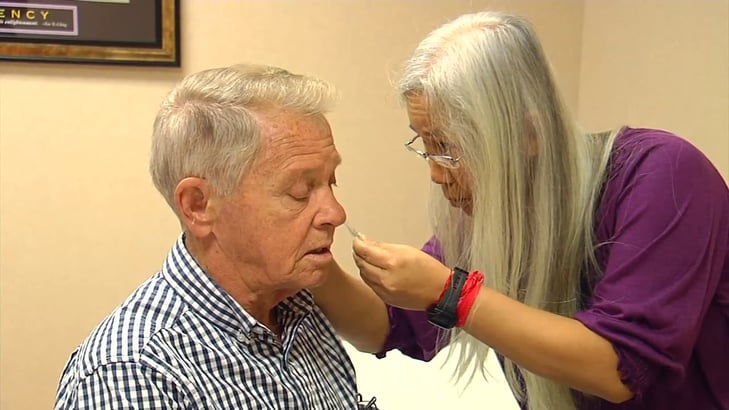
May is Skin Cancer Detection and Prevention Month. Why do we need a month dedicated to raising awareness about skin cancer? Because it’s the seventh most common form of cancer occurring in the United States.
Every year, more than 71,000 people Americans are diagnosed with melanomas of the skin, according to the U.S. Centers for Disease Control and Prevention (CDC). Of those, about 9,000 die from the disease. And as the population ages, that number is expected to continue growing.
If you’re a senior living in Cincinnati, you need to make sure you know the difference between normal aging skin and potential sign of something worse. Today, let’s review five skin cancer warning signs for which you and your loved ones can be on the lookout.
1. Know your ABCs
Unlike internal cancers, skin cancers can be detectable simply by keeping a close eye on your skin. They’re typically visible from their earliest stages (especially melanomas, which tend to be darkly pigmented) — if you know what to look for. Most start out as simple moles or other dysplastic skin growths, then progress.
Most dermatologists are trained to go by the “ABCDE rule.” This is a mnemonic way of remembering the signs of skin cancer. You should see your doctor if you notice spots, moles, or growths that exhibit any of the following features:
- Asymmetry: One half of a mole or mark does not match the shape of the other half.
- Border: If the edges of a mole or mark appear irregular, ragged, notched or blurred, something dangerous may be in play.
- Color: If a mole or mark shows different shades of brown or black, sometimes with patches of pink, red, white or blue, it could be cancerous. Don’t rely on color as a sole marker, though — some melanomas have no color at all.
- Diameter: If a spot is larger than 6 millimeters across (about one-quarter of an inch – the size of a pencil eraser), it’s suspicious. But don’t count on all melanomas or skin cancers to appear that large — they can often be smaller, especially in the early goings.
- Evolving: If your mole is changing in size, shape, or color, see a doctor immediately. This is a red flag.
2. Watch out for non-healing wounds or sores
A non-healing or slow-to-heal sore may not be what it, at first, appears to be. Often, squamous cell skin cancers or melanomas can present as open, non-healing sores. Basal cell skin cancers tend to start as red bumps.
Likewise, a mole that begins bleeding, oozing, that becomes red or inflamed (especially if the redness or soreness extends beyond the border of the mole), or that exhibits a scaly appearance, is suspicious for skin cancer.
🌤 View More: Suncreen Facts [PDF 📑 ]
3. If the mole or mark hurts, get it checked out
Normal moles don’t hurt or itch. If you begin to experience pain or itchiness around a mole or birthmark, make an immediate appointment with your doctor or dermatologist.
These symptoms are often indicative of inflammation that occurs as your body responds to, and unsuccessfully tries to eliminate, cancer cells infiltrating surrounding, healthy tissue.
4. Pay close attention to “ugly ducklings”

Some people naturally have a lot of moles. That’s nothing abnormal. But any mole or birthmark that looks significantly different or darker than surrounding moles or marks — especially if they are darker, larger, or differently shaped — is suspicious.
Dermatologists call such moles “ugly ducklings.” If you notice one, duck into your doctor’s office for a skin check.
5. Don’t forget to have a loved one check your back
Even if a senior is performing regular self-checks for skin cancer, early stage growths can go unnoticed if they occur in areas that aren’t easily visualized.
Make sure that you have a loved one, or your doctor, regularly check your back, the top of your head, the backs of your legs, arms and neck for growths you may have missed.
Those are the big warning signs. Now make sure you also take skin cancer prevention steps.
When you go outdoors this summer, wear SPF 30 sunscreen and a wide-brimmed hat — even on partly cloudy or overcast days. Damaging ultraviolet (UV) light from the sun is counterintuitively more likely to damage your skin when it’s hazy out, because clouds reflect some of it back down to the ground, rather than allowing it to escape back into space.
It’s also a good idea to wear UV-screening sunglasses when you’re outside. UV light can damage your eyes and accelerate cataract development or other degenerative changes.
Remember that an estimated 90 percent of melanomas are caused by UV exposure. Avoid excessive sunbathing. Never use artificial tanning beds; these deliver far more UV exposure than being outside on the average sunny day.
If you’re a senior living in Cincinnati, be kind to your skin this summer. Keep a close eye out for cancer warning signs.












